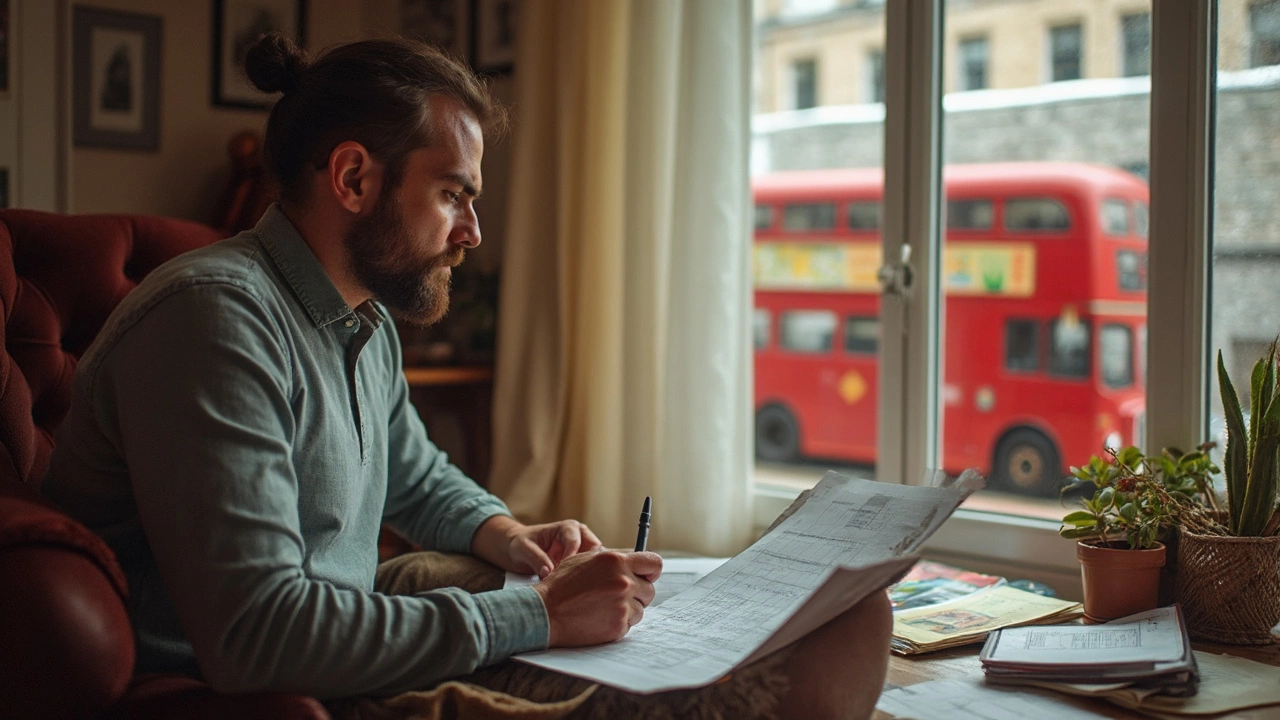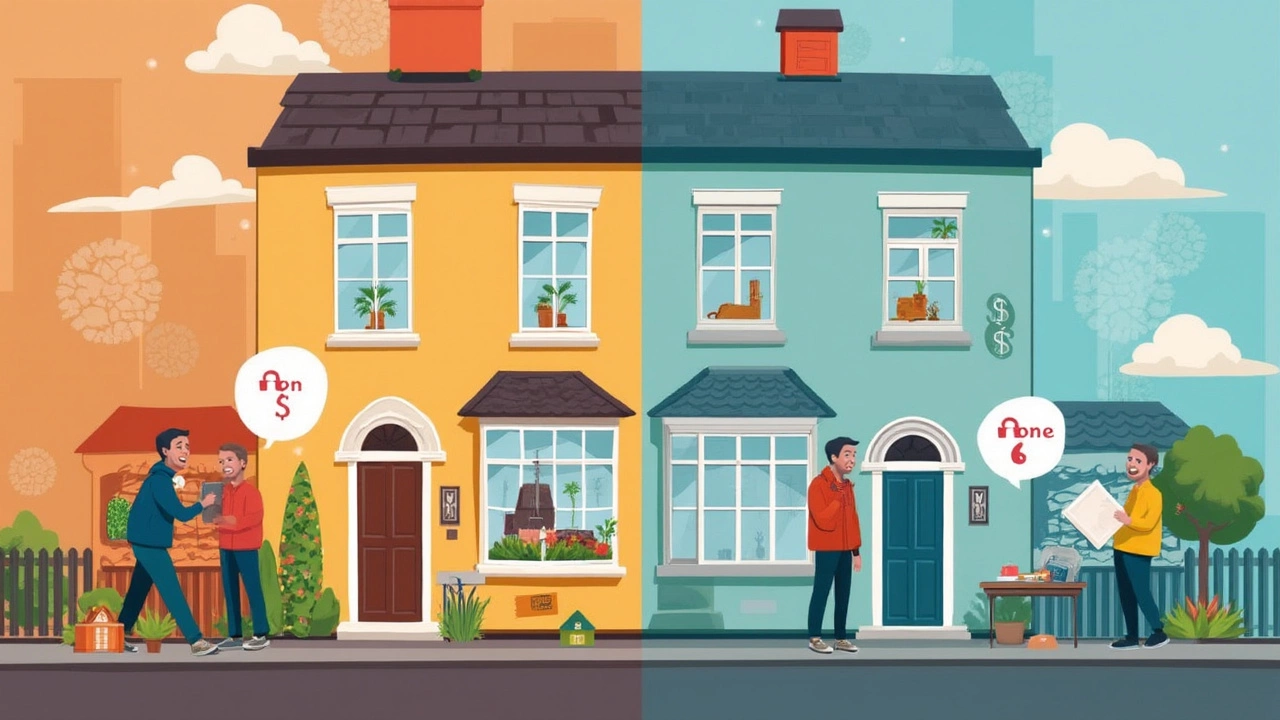How Much Profit Should You Make on a Rental Property?
 Apr, 18 2025
Apr, 18 2025
Chasing after a rental property can feel like hunting for treasure, but the real question is: how much should you actually make in profit for it to be worth it? Loads of landlords expect massive returns, but the truth is, solid profits aren’t always headline-worthy. Most of the big gains you hear about leave out the boring, expensive bits—like repairs, taxes, and the cost of finding new tenants.
If you pull up any buy to let calculator online, you’ll see numbers like 6% rental yield tossed around as the gold standard. But does that really tell you what you’ll pocket at the end of the month? Not quite. Knowing how to figure out real profit means looking past the surface and getting into the numbers that matter—after all the outgoings are paid.
- What Counts as 'Profit' in Buy to Let?
- How to Calculate Rental Profit: The Key Formulas
- What's a 'Good' Profit Margin—And What to Watch Out For
- Boosting Your Earnings: Practical Tips
What Counts as 'Profit' in Buy to Let?
So what does “profit” really mean when you own a rental? It’s not just the rent you collect every month. Rental property profit gets sliced up by all kinds of costs—some obvious, some sneaky. If you just look at the rent coming in, you’ll miss the real story.
Let’s break it down. There are actually two types of profit you need to keep in mind:
- Gross profit: This is the money you have left after taking out basic running costs (like mortgage payments, insurance, and property management fees) from your rental income. But it’s not your true take-home.
- Net profit: This is where it gets real. Here you’ll subtract everything else—repairs, letting agent fees, void periods when nobody’s renting, even stuff like gas safety checks and licensing fees. What’s left is what goes in your pocket.
It’s easy to forget costs like annual maintenance or making a place compliant with local Council rules—and they add up fast. For example, fixing a boiler or dealing with damp isn’t just an occasional headache—it’s a big hit to your buy to let bottom line.
Here’s a simple breakdown of what most landlords face each year:
| Cost | Annual Estimate (GBP) |
|---|---|
| Letting agent fees | £900 |
| Maintenance/repairs | £700 |
| Insurance | £250 |
| Void periods | £600 |
The key is: what you keep each year after all expenses is your real rental profit. Any analysis that leaves these out is just wishful thinking.

How to Calculate Rental Profit: The Key Formulas
Think of calculating rental property profit as putting together a shopping receipt. You need to see the whole bill—not just what you paid upfront.
Start with gross rental yield. This is the one you’ll see splashed on sales listings. The formula is simple:
- Add up your annual rent from tenants.
- Divide that by the property’s price.
- Multiply by 100 to get the percentage.
For example, say your property costs £200,000, and the yearly rent is £12,000. Your gross rental yield:
- 12,000 ÷ 200,000 × 100 = 6%
But here’s where too many landlords slip up. Net rental profit matters more because it factors in actual running costs. Here’s what to include:
- Mortgage interest (don’t count repayments on the loan).
- Repairs and maintenance—think boilers, paint, and quick fixes.
- Letting agent or management fees if you use them.
- Insurance (landlord, buildings, contents, etc.).
- Ground rent and service charges (for flats or leaseholds).
- Void periods where you have no tenant.
The go-to formula for your real monthly profit is:
- (Monthly Rent – Monthly Expenses) = Net Monthly Profit
If you want to check the property’s performance on paper, try this one for net rental yield:
- (Annual Rent – Annual Expenses) ÷ Property Price × 100
| Expense Type | Typical Annual Cost (UK Example) |
|---|---|
| Mortgage Interest | £3,600 |
| Repairs & Maintenance | £1,200 |
| Agent Fees | £900 |
| Insurance | £200 |
| Ground Rent/Service Charges | £500 |
One quick tip: Make a spreadsheet with your expected rent, all the costs above, and let it do the math. You'll spot if a place works—or if it eats your savings year after year.

Boosting Your Earnings: Practical Tips
If you want to see real growth in your rental property profit, you need more than just collecting the rent every month. Landlords who get creative and pay attention to details often see far better returns than those who just stick to the basics.
First, keep your property in great condition. Well-maintained homes attract better tenants who tend to stay longer and look after the place. A fresh paint job, updated appliances, or even just new flooring can justify a higher rent and reduce those annoying void periods when the place sits empty.
Next up, don’t just automatically renew to the same tenants at the same rate every year. Be proactive—check what similar properties go for in your area. According to HomeLet's 2024 April Rental Index, rents in the UK rose by about 7% year-on-year, but lots of landlords left money on the table by not adjusting their prices.
- Renovate smartly: Kitchens and bathrooms drive up value. Even little changes, like replacing tired worktops or swapping worn taps for modern ones, can help justify a rent bump.
- Choose location wisely: Properties near schools, stations, and shops stay in demand even when the market cools off. That means steadier income and fewer weeks with no rent coming in.
- Review your mortgage: Don't just accept whatever rate your lender gives you on renewal. Switching to a better buy-to-let mortgage can seriously bump up your property investment profits.
- Keep an eye on expenses: Simple things like swapping old bulbs for LEDs or fixing leaky taps straight away can shave hundreds off your yearly costs.
Let’s be real—void periods are profit killers. Try to keep tenants happy with quick repairs, regular communication, and the odd small gesture (think a welcome pack). Happy tenants usually stick around, which means less hassle and less money lost between lets.
It also helps to diversify. If you can afford more than one property, putting money into a different area or a slightly different property type can balance out risks. That way, if one area stagnates, another might boom and keep your rental yield healthy.
Want to see how the small stuff adds up? Here’s a quick comparison:
| Action | Estimated Yearly Profit Gain |
|---|---|
| Raise rent by 5% after tenant renewal | £900 (on £1,500/mo rent) |
| Switch to lower rate mortgage (save 0.5%) | £600 |
| Cut utility upgrades (LEDs, insulation) | £150 |
Stacking just a few of these moves can add thousands to your rental property profit every year. Stay sharp, don’t get too comfortable, and keep looking for new ways to squeeze more value out of your investment—it’s how the pros do it.